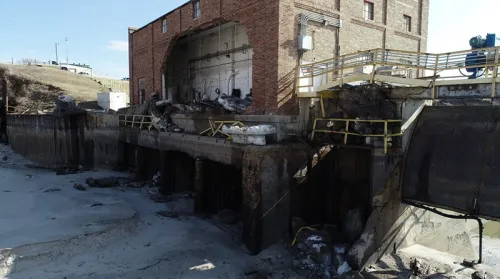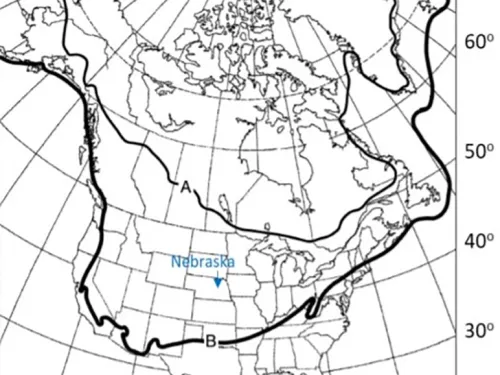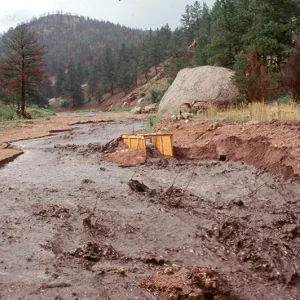Spencer Dam (Nebraska, 2019)
Spencer Dam was a dam constructed for hydropower in 1927 on the Niobrara River in northern Nebraska. The dam consisted of a 3,200-foot-long embankment section and a 500-foot-long powerhouse/spillway section. The dam’s maximum height was 26 feet. The spillway consisted of four 33.5-foot-wide bays controlled by Tainter gates, one 10-foot-wide trash/ice bay with a Tainter gate, and five 33.5-foot-wide stoplog bays. The stoplog bays were operated from a walkway above the bays where the dam operators would use a jack to lift the steel needle beam holding the stoplogs in place. [See photos No. 10 and 11] When jacked upward, the needle beam rose out of a lower pocket, the lower end pivoted downstream, and the wooden stoplog planks on each side of the beam were released allowing flow downstream.
The Niobrara River had only one dam (Spencer). At that location, the river valley was about a mile wide. The river’s morphology at the dam was sinuous and braided, and therefore relatively shallow compared to the river’s width.
The dam was operated as a run-of-the-river facility with a small reservoir (8,300 ac-ft capacity). Siltation of the reservoir was a continual issue and required biannual sluicing. The dam was assigned a Significant hazard classification meaning that failure or misoperation of the dam would result in no probable loss of human life but could result in major economic loss, environmental damage, or disruption of lifeline facilities. There was a home, a music stage, a small RV park and a saloon 1/3 mile downstream from the dam. Four bridges crossed the river downstream from the dam and the village of Niobrara was 38 miles downstream. There was no Emergency Action Plan for the dam.
Three major ice run events had damaged the dam in the past: in 1935 the dam’s embankment was breached by an ice run and in 1960 and 1966 the dam was heavily damaged by ice runs. Due to the passage of time, turnover of employees, and destruction of records in the 1966 ice run, both the owner and the regulator (Nebraska Department of Natural Resources Dam Safety program) had little knowledge of the dam’s vulnerability to ice runs.

The location of Spencer Dam is in one of the most dynamic fluctuating weather patterns of North America. Frigid winters cause ice to form on many rivers. The warming periods of many springs causes major ice runs and jams along the state’s rivers.
An adverse convergence of factors related to the physical setting of Spencer Dam led to an ice event that overwhelmed and failed the dam early in the morning of March 14, 2019. Though such an event could be deemed infrequent, the dam’s mode of failure was foreseeable because the dam was on a river with a history of ice runs. - Spencer Dam Failure Investigation Report, p. 50

The failure event involved the following sequence of events:
- After a colder than normal winter, in early March there was approximately 1-foot of snow on frozen ground in the upper section of the Niobrara River basin.
- Winter storm Ulmer became a bomb cyclone on Wednesday, March 13. It was a major event that affected much of the Great Plains. The storm dropped about 2 inches of rain on the melting snow. As the evening progressed the rain became freezing rain, with wind speeds in excess of 60 miles per hour. Blizzard-like conditions prevailed as the bomb cyclone passed over the watershed of the Niobrara River.
- The rapid increase in runoff entering the Niobrara River, whose ice cover was thick and intact, led to a dynamic breakup of the river’s ice sometime during the evening of March 13. The resulting ice rubble drifted downstream until it congested and jammed at locations where the river narrowed or at locations where the flow was restricted including bridges and river bends. Once an ice jam formed, water backed up behind the jam and released due to pressure from backed-up water/ice and erosion of the river’s sand boundaries. The ice rubble continued to jam and release as it moved downstream. The magnitude of the ice rubble and surging water increased and entered Spencer reservoir at approximately 5:00 AM the following morning (March 14, 2019).
- As inflows to the reservoir increased through the night of March 13/14, the dam’s two operators opened all five Tainter gates (lifting the gates to allow flow underneath). Around 2:00 AM, the lifting chain at Gate No. 3 broke and the gate fell down into the closed position. The operators could only open approximately half of the stoplog bays because of ice on the stoplogs and needle beams.
- At 4:38 AM, one of the operators witnessed water entering the powerhouse trashrake room, with a floor elevation 5.75 feet below the dam crest. Fearing the dam was in peril, the operators decided to drive to the other end of the spillway (the exposed walkway was icy with high winds) to try to release the remaining stoplog needle beams.
- Upon arriving at the gate to the embankment access road, the operators saw water on it and water overtopping the dam. They turned around and decided to warn the downstream homeowner. After pounding on the door and hearing a dog barking, the owner answered the door. The operators warned the owner that the dam was failing and that he needed to evacuate. The operators said they thought the resident clearly understood them when they told him that he needed to leave “now”. On returning to the powerplant, they saw three fireballs at the electrical substation and later saw a large hole in the west wall of the brick superstructure of the powerhouse. They called 911.
- The homeowner could not be located after the event. His home and the other structures were swept downstream by the dam failure. The owner was later declared dead by drowning.
- Evidence from inside the powerhouse showed that the reservoir water had risen at least two feet over the dam crest. Two large breaches existed in the embankment dam after the event. Large pieces of ice rubble remained on the crest of the dam following the event. Numerous areas on the downstream slope of the embankment had erosion from overtopping. The investigative panel concluded that the dam had failed from overtopping during a major ice run on the river. The panel concluded that the flood damage in the town of Niobrara downstream was due to the ice run and that the dam failure’s contribution to the flood volume was negligible.
References:
This case study summary was peer-reviewed by Martin Teal P.E., WEST Consultants, Inc; Rob Ettema P.E., PhD, Department of Civil & Environmental Engineering, College of Engineering, Colorado State University; and John Trojanowski, P.E., Trojanowski Dam Engineering.






Lessons Learned

A complete and thorough dam record is essential.
Learn more
Dam incidents and failures can fundamentally be attributed to human factors.
Learn more
Dams in cold regions should account for ice.
Learn more
Emergency Action Plans can save lives and must be updated, understood, and practiced regularly to be effective.
Learn more
Floods can occur due to unusual or changing hydrologic conditions.
Learn more
Forensic investigations are needed for major dam failures and incidents in order to determine the history of the contributing physical and human factors, and the culminating physical failure modes and mechanisms.
Learn more
Natural dams can form quickly through processes such as landslides, avalanches, and river ice jams. In some cases, the formation of natural dams requires prompt intervention to protect people and property.
Learn more
Past successful dam performance does not guarantee future successful performance.
Learn more
The Study of Past Dam Failures and Incidents is Essential for Keeping Today’s Dams Safe.
Learn more
The study of past incidents and failures aids in the assessment of existing dams.
Learn moreAdditional Lessons Learned (Not Yet Developed)
- Dams should be evaluated for their vulnerability to ice runs where these conditions can develop.
- Designers must incorporate knowledge of local conditions.
- More river-ice research is needed.
- The dam safety industry needs to improve Downstream Hazard Classification practices.
Note: See the Spencer Dam Failure investigation report for additional findings and lessons.

Avoiding Disaster: Assuring Warning Compliance

Dam Failure and Incident Investigation Guide

Engineering and Design: Ice Engineering

Flow Control to Manage River Ice

Human Factors in Dam Failures

Risk Management - Best Practices and Risk Methodology











